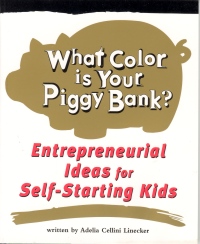| ________________
CM . . .
. Volume XI Number 6 . . . .November 12, 2004
excerpt:
In its title, Adelia Cellini Linecker's What Color is Your Piggy Bank? alludes to Richard Bolles's highly successful, annually published handbook What Color is Your Parachute? for adult job-hunters and career-changers. Yet the "piggy bank" reference and its subtitle clearly mark Linecker's book as one specifically for independent-minded children and teens who want to go into business for themselves. However, whereas Bolles has cornered the Mother Goose of golden eggs, it remains to be seen whether Linecker's text will bring in more than a few small nuggets given the recent rush of books about kids and money. As this reviewer picked up What Color is Your Piggy Bank? she could imagine the theme song to The Apprentice playing in the background: "Money, money, money, money, money." The polished cover, of a substantial weight, and with the prominent silhouette of a large, gold pig on its front, certainly suggests wealth. In fact, the golden touch courses throughout the book, coloring sidebars, headings, and illustrations. Whereas The Kids Guide to Money Cent$ by Keltie Thomas incorporates a narrative and plenty of color in a comic-book format, What Color is Your Piggy Bank? takes a more conservative approach to color and format, making it more suitable for a slightly older audience. This book's small dimensions (16 cm x 20 cm) belie its grand intentions. Via the tripartite structure of "The World of Jobs," "Setting Up Shop," and "Managing Your Money," Linecker pledges to help the reader "earn money, save money, and give money away (to charity)." (p. 5). Young entrepreneurs will benefit from the author's creative "New Twists on Traditional Jobs," a chapter that explores ways in which kids can add to or adapt services such as babysitting, lawn-mowing, and dog-walking. Linecker also covers topics like scheduling, partnerships, promotions, saving, and investing, all of which emphasize the worth of entrepreneurial forethought and flexibility. Along with its "how-to" advice, the book introduces quotations, quizzes, and website addresses. In addition, "True Story" columns introduce readers to actual young entrepreneurs like 15-year-old Daniel Miller, Jr. who designs and sells stationery products to raise money for cancer research (p. 86-88). To close the book, a glossary simplifies business terminology for beginners while an appendix bestows extra tips related to four kid-appropriate jobs that it revisits. Since chapters are short, no index is necessary. Still, what tarnishes an otherwise acceptable book is its unevenness in scope and style. For instance, chapter 13's four pages on "Charity and Volunteering" read as an afterthought, tacked on just so that the book might meet its third declared purpose. In contrast, the preceding chapter spends ten pages explaining to readers how the stock market operates. For such a short book, there are also a high proportion of errors that slipped by proofreaders. In one case, the informal "buck" and the formal "frugal" appear only a few sentences apart (p. 109). In a paragraph on spending habits, the omission of the word "ticket" after "concert" seriously ups the ante of "stuff you buy every week" (p. 105). Other oversights include the use of "attract" in place of "attractive" (p. 142), a comma splice (p.15), a problem with subject-verb agreement (p. 117), and a website missing an extra zero in its address (p. 119). Such inattention to detail devalues the professional image of What Color is Your Piggy Bank? Canadian readers may feel additionally shortchanged. Although the book is published by Lobster Press in Montreal, its author is based in L.A.; consequently, despite Linecker's attempt to forge a North American context, the book sells out Canadian content in favor of a subtle yet salient U.S. bias. The majority of websites, for example, list headquarters in the U.S. Additionally, the "True Stories" highlight the influence of exemplary young people from Pennsylvania, Carolina, and Nebraska. Surely had Linecker been so inclined she would have uncovered local treasure Hannah Taylor, an eight-year-old who has raised at least $125,000 for Winnipeg's homeless persons, and others like her. To establish a balanced representation of North America, What Color is Your Piggy Bank? needs to pay a little more attention to the country north of the 49th parallel. So although What Color is Your Piggy Bank? may strike it rich, or at least buy itself some time on the shelves of bookstores and libraries, there's a streak of gold-digger in it. Recommended. Julie Chychota has an M.A. in English and is employed by the University of Manitoba and Red River College in Winnipeg, MB.
To comment
on this title or this review, send mail to cm@umanitoba.ca.
Copyright © the Manitoba Library Association. Reproduction for personal
use is permitted only if this copyright notice is maintained. Any
other reproduction is prohibited without permission.
NEXT REVIEW |
TABLE OF CONTENTS FOR THIS ISSUE
- November 12, 2004.
AUTHORS |
TITLES |
MEDIA REVIEWS |
PROFILES |
BACK ISSUES |
SEARCH |
CMARCHIVE |
HOME |
